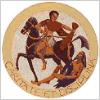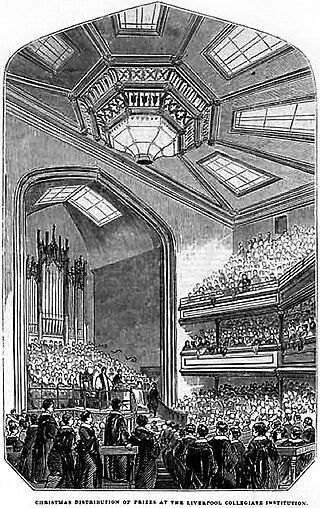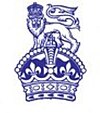
Tulse Hill is a district in the London Borough of Lambeth in South London that sits on Brockwell Park. It is approximately five miles from Charing Cross and is bordered by Brixton, Dulwich, Herne Hill, Streatham and West Norwood.

A grammar school is one of several different types of school in the history of education in the United Kingdom and other English-speaking countries, originally a school teaching Latin, but more recently an academically oriented selective secondary school.

Sheldon School is a large mixed secondary school and sixth form in Chippenham, Wiltshire for students aged 11 to 18 and is the largest school in Wiltshire. Since April 2011, it has been an Academy. It is one of three secondary schools in Chippenham, the others being Abbeyfield and Hardenhuish. The school is headed by Peter Lynch, former Headteacher of Bradley Stoke Community School, who was appointed in September 2023.The school is off the Hardenhuish Lane in the southern region of Hardenhuish Park, which is all that separates it from Hardenhuish School to the north.

Wolverhampton Grammar School is a co-educational private school in Wolverhampton, England.

Wisbech Grammar School is an 11–18 co-educational, Church of England, private day school and sixth form in Wisbech, Isle of Ely, Cambridgeshire, England. Founded by the Guild of the Holy Trinity in 1379, it is one of the oldest schools in the country.

Derby School was a school in Derby in the English Midlands from 1160 to 1989. It had an almost continuous history of education of over eight centuries. For most of that time it was a grammar school for boys. The school became co-educational and comprehensive in 1972 and was closed in 1989. In 1994 a new independent school called Derby Grammar School for boys was founded.
Clapham College was a Roman Catholic secondary school for boys in South London.
The Elms Academy is a mixed secondary academy in the London borough of Lambeth. Its sponsor is United Learning.

Tulse Hill School was a large comprehensive school for boys in Upper Tulse Hill, in the London Borough of Lambeth, England. The school building had eight floors and served almost two thousand pupils. It opened in 1956 and closed in 1990. Notable alumni include Ken Livingstone, the former London Mayor, and poet Linton Kwesi Johnson.
Dick Sheppard School was a large school, originally for girls, at Tulse Hill in the London Borough of Lambeth. It was founded as the sister establishment to Tulse Hill School for boys and as the Comprehensive alternative to St Martin-In-The-Fields High School for Girls. In the late 1970s it absorbed the remaining male pupils of nearby Strand School and continued as a co-educational school until its closure in 1994.

St Martin-in-the-Fields High School for Girls was one of the oldest schools for girls in Britain. It was established in 1699 as a charitable enterprise by the parish of St Martin-in-the-Fields. Its popularity and growth led to its relocation in 1928 on a larger site in Tulse Hill, in the South London borough of Lambeth, England. For most of its history it was a grammar school, but at its closure in 2024 it was a secondary school with academy status.
Elm Wood School is a primary school based at the southern end of the inner London Borough of Lambeth. The school has gone through a number of changes since its establishment at the beginning of the twentieth century reflecting the changing policies of local and national governing authorities as well as the changing nature of the community it serves.
The Elmgreen School is a coeducational secondary school and sixth form located in the West Norwood area of the London Borough of Lambeth, England. It was the first Parent Promoted secondary school to be created in the UK under the School Standards and Framework Act 1998.
Ilkeston Grammar School was a selective co-educational secondary school, admission being dependent on passing the 11-plus examination. It stood on King George Avenue, Ilkeston, in the south east of Derbyshire in the East Midlands of England.

Richmond Park Academy is a secondary school with an academy status in the London Borough of Richmond upon Thames. The school is part of the Academies Enterprise Trust academy chain.
Matthew Humberstone Church of England School, also known as the Matthew Humberstone School, Matthew Humberstone C of E School, Matthew Humberstone Comprehensive School, MHS and Matty, was a secondary school in Cleethorpes, North East Lincolnshire, England, with a Church of England tradition. It existed between 1973 until it was closed due to amalgamation in 2010.
Poundswick Grammar School or PGS was a mainstream secondary school in the Poundswick Corridor of "Wythenshawe" and at its peak had over 500 pupils.

Thames Valley Grammar School was a co-educational grammar school in Twickenham, London Borough of Richmond upon Thames, England.

Liverpool Collegiate School was an all-boys grammar school, later a comprehensive school, in the Everton area of Liverpool.

Lincoln Grammar School or Lincoln Free School was formed as the result of the amalgamation of the Lincoln City Free School and the Lincoln Chapter Grammar School. The amalgamation occurred in January 1584, but the two schools may have been effectively working as single school from 1560. In 1574 Lincoln City Corporation had reached an agreement with Robert Monson who was donating the Greyfriars for use as a Grammar School. This was to replace an older City Free school, which had been in scholegate. The exact location of this Free school is uncertain, but scholegate probably refers to Danesgate, but other evidence suggests that the earlier school was close to St Rumbold's church.
















